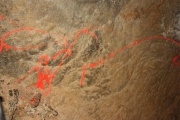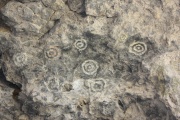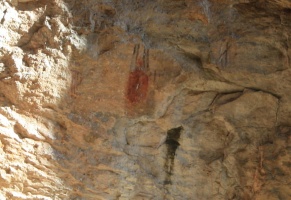Graffiti (Inventory)
From LagWiki
| Line 1: | Line 1: | ||
| - | The '''graffiti''' | + | The '''graffiti''' section should be used to list stations which exhibit some type of intentional human made marking. [[Graffiti (Inventory)/Pictographs|pictographs]] have their own field. The medium for these marks could be: pencil, pen, paint, carbide, scratches in calcite, mud or clay and any number of other media. Graffiti marks tend to be signatures or initials or some type of identifying mark and often include a date but not necessarily. The markings may be historic or not depending upon their age and significance. When looking for graffiti marks, pay particular attention around the deepest areas of the cave near dead ends especially if the area is large enough in which to sit or stand comfortably. These types of locations seem to attract graffiti. Pictographs are more often found in the twilight areas; but, graffiti is common there, too. |
| - | + | ||
| - | + | ||
On the ''CCNP Cave Inventory Form'', the [[Recorder (Inventory)|recorder]] is asked to include a description and approximate age for all graffiti. Include this information next to the station. If the mark seems historic, recent or significant, a photograph could be helpful. | On the ''CCNP Cave Inventory Form'', the [[Recorder (Inventory)|recorder]] is asked to include a description and approximate age for all graffiti. Include this information next to the station. If the mark seems historic, recent or significant, a photograph could be helpful. | ||
| - | == | + | ==Pictographs== |
| - | + | {{:Graffiti (Inventory)/Pictographs}} | |
| + | {{clear}} | ||
| - | == | + | ==Other== |
| - | + | {{:Graffiti (Inventory)/Other}} | |
| - | + | {{clear}} | |
{{Cave inventory}} | {{Cave inventory}} | ||
| - | |||
Revision as of 04:03, 26 April 2011
The graffiti section should be used to list stations which exhibit some type of intentional human made marking. pictographs have their own field. The medium for these marks could be: pencil, pen, paint, carbide, scratches in calcite, mud or clay and any number of other media. Graffiti marks tend to be signatures or initials or some type of identifying mark and often include a date but not necessarily. The markings may be historic or not depending upon their age and significance. When looking for graffiti marks, pay particular attention around the deepest areas of the cave near dead ends especially if the area is large enough in which to sit or stand comfortably. These types of locations seem to attract graffiti. Pictographs are more often found in the twilight areas; but, graffiti is common there, too.
On the CCNP Cave Inventory Form, the recorder is asked to include a description and approximate age for all graffiti. Include this information next to the station. If the mark seems historic, recent or significant, a photograph could be helpful.
Contents |
Pictographs
The Pictographs field of the Graffiti section should be used to record stations where pictographs are observed.
A pictograph is a prehistoric drawing or form of symbolic artwork and can be found within caves. True pictographs are of significant cultural and anthropological importance. Pictographs are most often found in the twilight portion of caves, near the entrance; but due to changes or other events, they could be found almost anywhere. The observation of something that appears to be a pictograph should not be discarded because of its location. The symbolic artwork may or may not be recognizable and because of age, it may even be very hard to identify. Red ochre, yellow ochre, charcoal black and white are common colors in pictographs. The pigments were often made of whatever colorful material could be collected. All that remains of a pictograph may be a faded, color blotch on a wall, so observe carefully especially near an entrance.
For purposes of cave inventory, the definition of pictograph should be broadly construed to include similar artwork such as petroglyphs. Basically, any kind of symbolic artform on the rock is inventoried in this field.
Pictographs, Graffiti
Other

The Other field of the Graffiti section should be used to list stations which exhibit some type of human made markings other than pictographs or graffiti. These may include things such as: paint marks, carbide marks (usually on the ceiling), scratches, pencil or pen marks, sculptures made of mud or clay, and other types of human made marks which are not of the pictograph or graffiti variety. Directional arrows in carbide, paint, and even lipstick or any other medium are examples.
On the CCNP Cave Inventory Form, the recorder is asked to include a description and approximate age for all graffiti. Include this information next to the station.
Example
- Graffiti, other: G23 (small clay sculpture with a university logo / 20 years)
See also
References
- Hildreth-Werker, Val and Werker, Jim C. (2006) Cave Conservation and Restoration National Speleological Society, Huntsville, AL pp 110,333-334 ISBN: 1-879961-15-6


